
Tempest Anderson Pioneer of Volcano Photography
THE YORKSHIRE MUSEUM - Pat Hadley, Sarah King and Stuart Ogilvy present a fascinating selection of photographs from the collection of Tempest Anderson, the pioneering Victorian volcanologist.
August 6, 2015
What could possess a respectable Victorian surgeon from York to spend much of his life travelling to remote and challenging parts of the world to study volcanoes and climb mountains?
For Tempest Anderson, pioneering new techniques of ophthalmic surgery and inventing photographic equipment was not enough. He decided that his ‘limited leisure’ time could not be filled with reading, writing or socialising, he sought to occupy himself with something more exciting: volcanology. For him, it was a branch of science that did not have too much literature and had the ‘advantage of offering exercise in the open air’: he saw the sides of volcanoes not as dangerous but ‘picturesque’
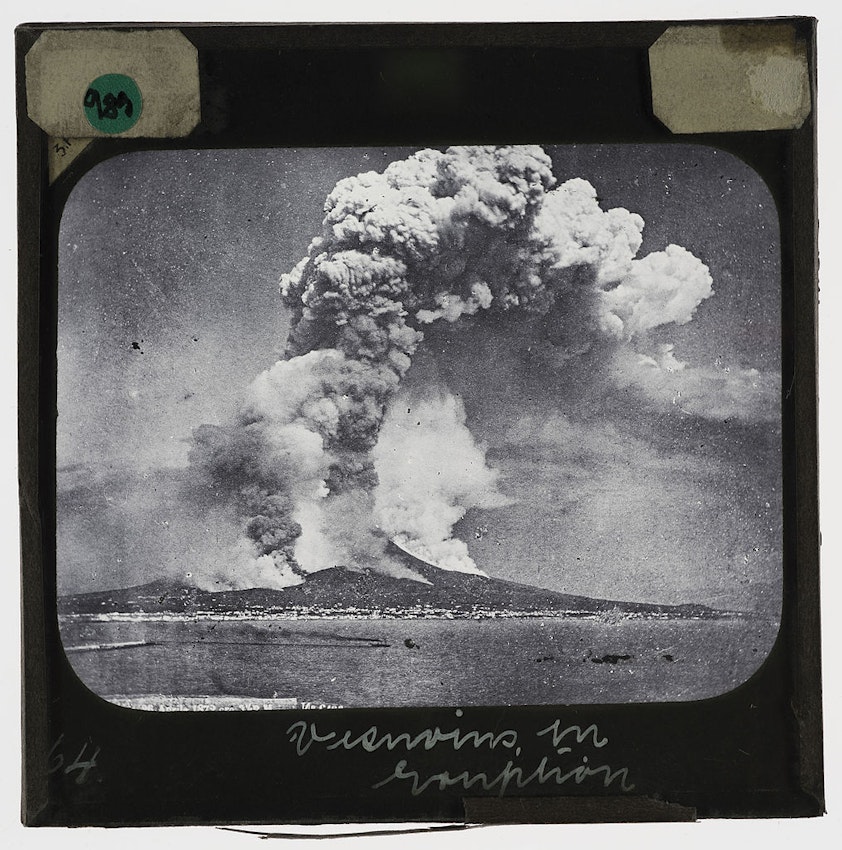 Scroll through the whole page to download all images before printing.
Scroll through the whole page to download all images before printing.Vesuvius in Eruption: taken from the sea – YORYM : TA989 (1906) - Source.
Anderson would return to York and lecture at the Yorkshire Philosophical Society using a ‘magic lantern’ to display his glass slides and reveal far-flung landscapes to the scientific community. At his death, he donated half his estate and most of his archive to the YPS, and it is through this inheritance at the Yorkshire Museum that some of the 5,000 glass slides have come to be digitized for York Museums Trust’s online collection and Wikimedia Commons.
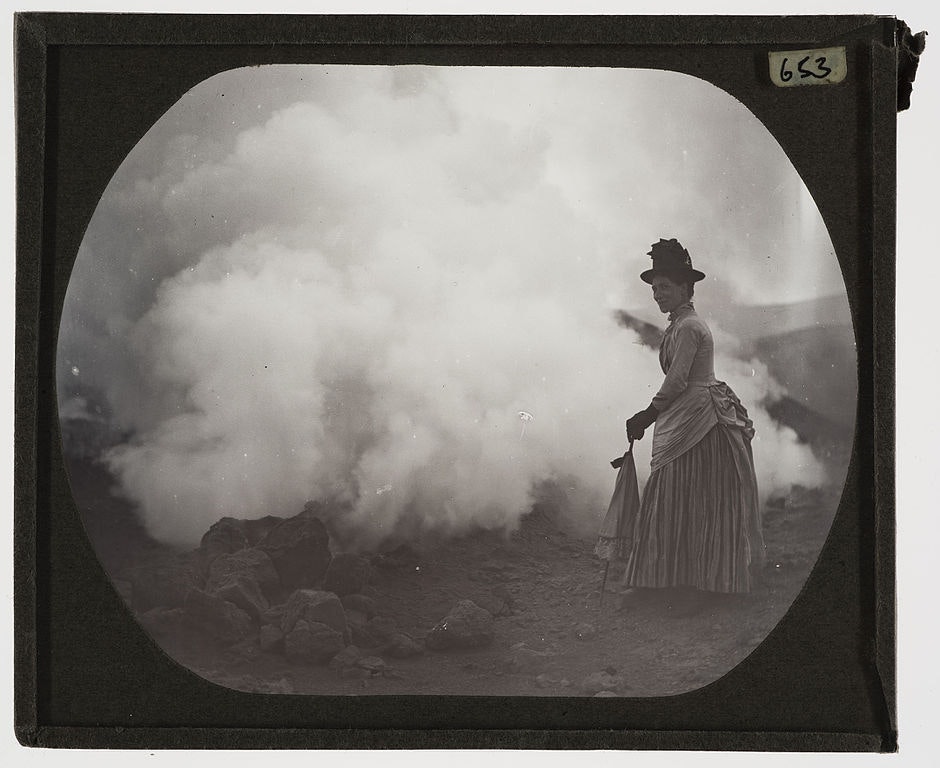 Scroll through the whole page to download all images before printing.
Scroll through the whole page to download all images before printing.A female adventurer and the steam on Vulcano – YORYM : TA653 (unknown year) - Source.
Anderson’s travels took him around the world. In an era when journeys were still unpredictable and difficult, he went to very remote areas to make detailed photographic studies of eruptions and their aftermath. His first few voyages were to European volcanic areas: Eifel in Germany, the Auvergne in France and Vesuvius, Etna and the Lipari islands of Italy.
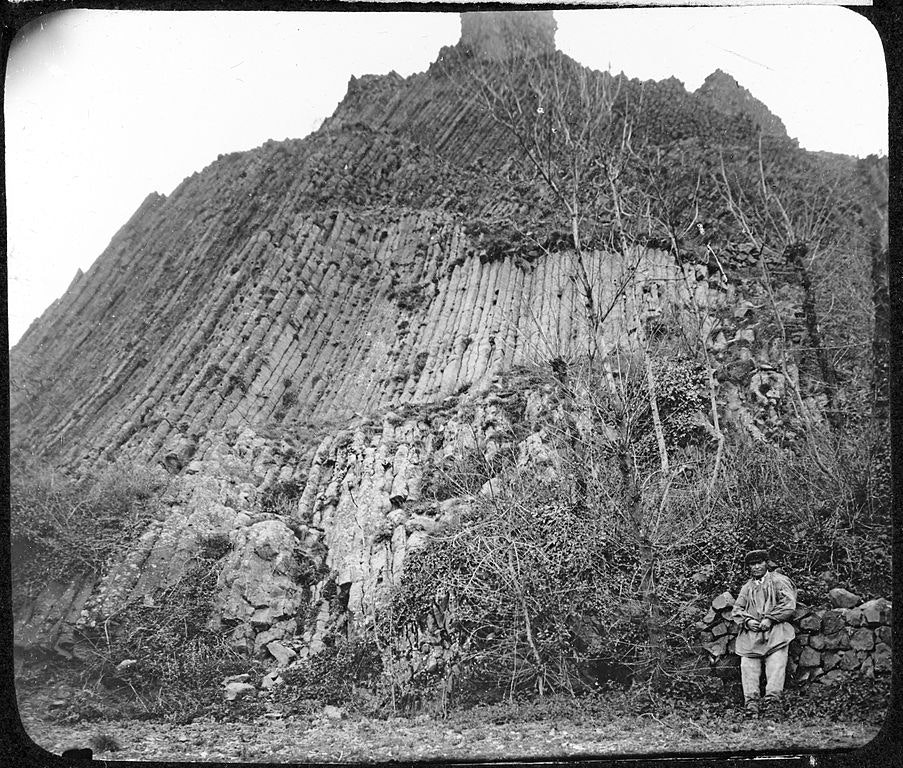 Scroll through the whole page to download all images before printing.
Scroll through the whole page to download all images before printing.A basalt neck at Buron near Coudes, Southern France - YORYM: TA0365 (1885) - Source.
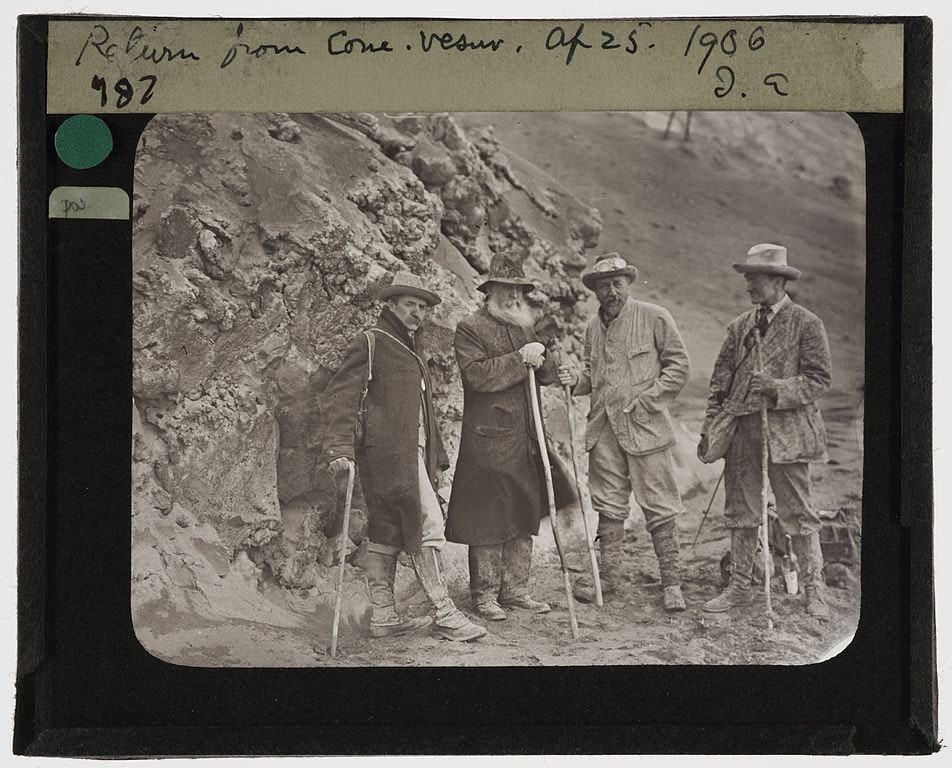 Scroll through the whole page to download all images before printing.
Scroll through the whole page to download all images before printing.Tempest Anderson (second from right) and three others returning from Vesuivius - YORYM_TA987 (1906) - Source.
He first attempted a bigger adventure in 1890 to Iceland and this was the first in a series of more ambitious trips to the Canaries, and North America.
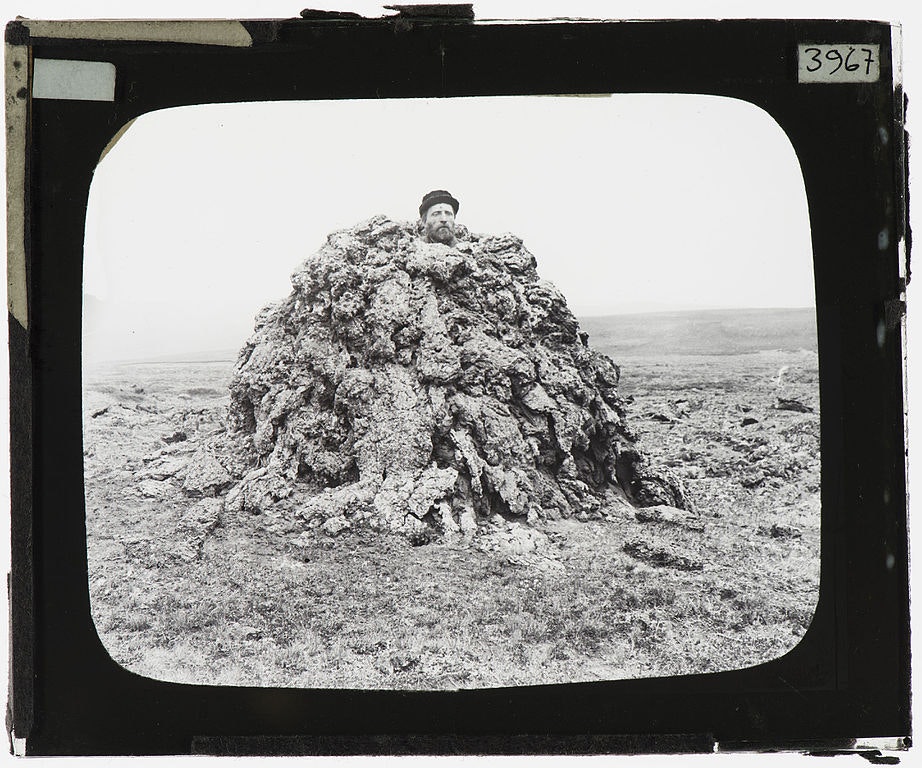 Scroll through the whole page to download all images before printing.
Scroll through the whole page to download all images before printing.A man in a spiracle, Iceland – YORYM : TA3967 (1893) - Source.
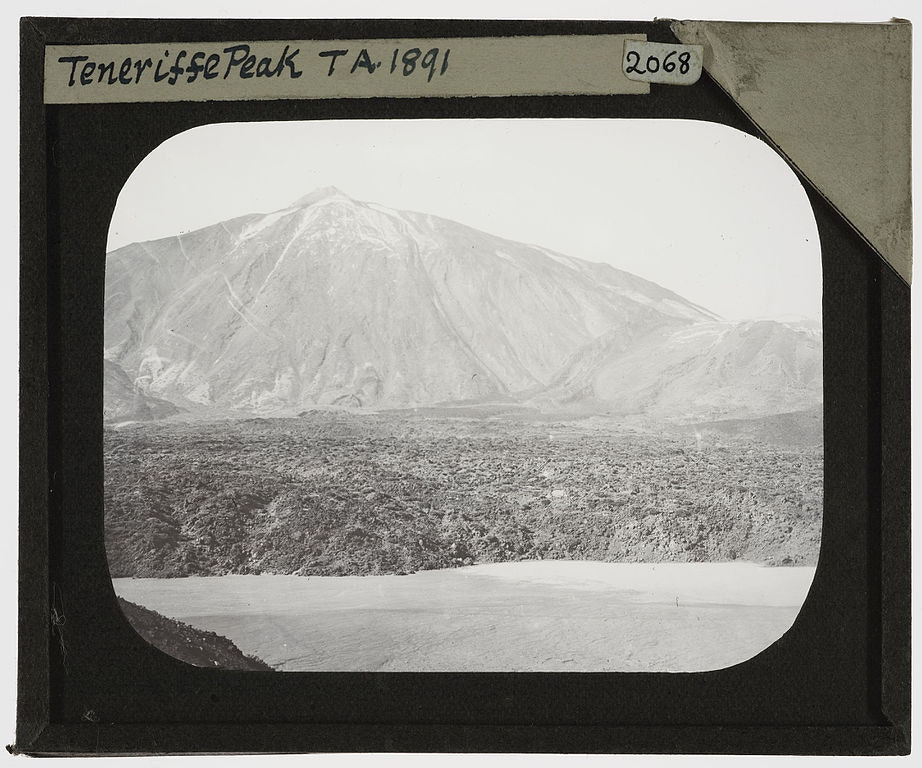 Scroll through the whole page to download all images before printing.
Scroll through the whole page to download all images before printing.Pico del Teide, Tenerife – YORYM : TA2068 (1891) - Source
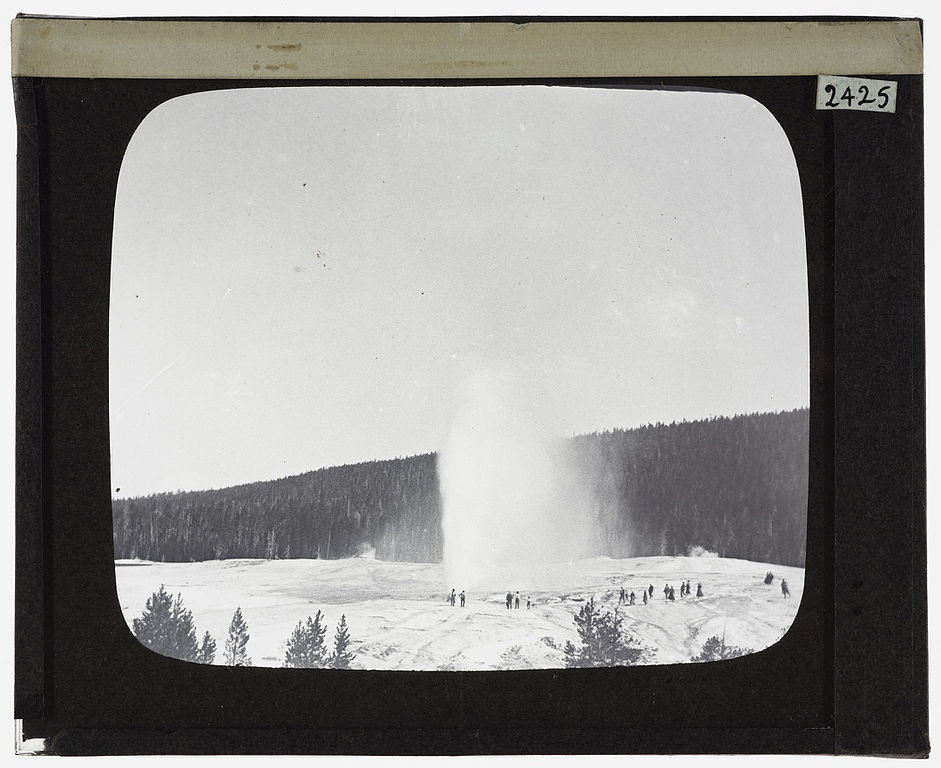 Scroll through the whole page to download all images before printing.
Scroll through the whole page to download all images before printing.A geyser erupting in Yellowstone National Park (possibly the Beehive Geyser) – YORYM : TA2425 (1900) - Source.
Over the course of these trips he established his skills as a photographer and his reputation as a keen observer and analyst of volcanic phenomena. As a result of the numerous papers and lectures he gave about these trips he - an amateur - was commissioned by the Royal Society to travel to St Vincent and Martinique in the Caribbean to study the aftermath of major eruptions in 1902.
Of all his expeditions, this had the greatest scientific legacy and left some of the most dramatic photographs. Though we lack access to Anderson’s diaries or papers, it has been possible to retrace many of the details of this expedition and pin down photos from the archive to specific days and passages in the report on the trip.
This map takes you through the whole journey. Some of the details - such as the trip through London and voyages between islands are a little unclear. Anderson was accompanied by John Flett, a young geologist who would go on to great things. What we do have are the amazing images Anderson took as they travelled through the islands. They studied the volcanoes and their effects in great detail. The main eruptions had taken place in early May with the worst completely destroying the town of Saint Pierre on Martinique and killing around 30,000 people.
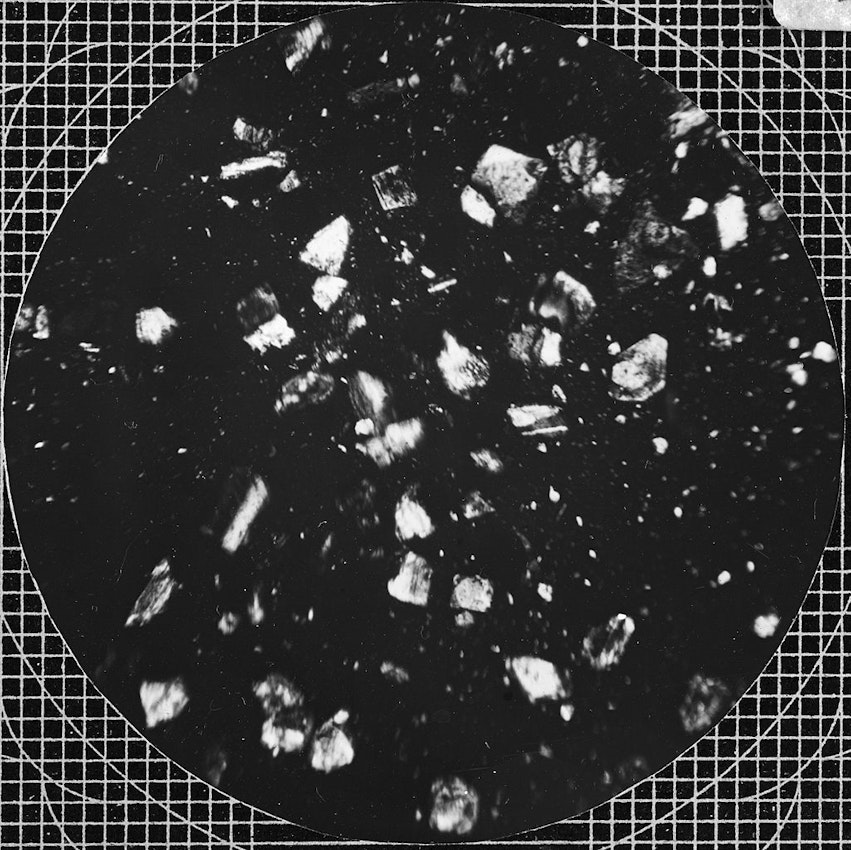 Scroll through the whole page to download all images before printing.
Scroll through the whole page to download all images before printing.A microscopic photograph of Volcanic dust from Mount Soufriere, St Vincent – YORYM : TA0019 (1902) - Source.
Studying the volcanic dust under a microscope allowed Anderson to identify how far the dust had blown across to other islands and the sequence of eruptions.
The most amazing event on the trip was on July 9 when they were on a small yacht - the Minerva of Grenada - off the coast of Martinique. They had been studying the shape of the volcano and the clouds of gas, ashes and steam that were being ejected at regular intervals. Anderson’s account of the evening is so dramatic and characteristic of his work that it bears repeating at length:
In the rapidly-falling twilight we sat on deck intently watching the activity of the volcano, and calculating the chances of an ascent next morning, when our attention was suddenly attracted to a cloud which was not exactly like any of the steam " cauliflowers " we had hitherto seen. It was globular, with a bulging, nodular surface ; at first glance not unlike an ordinary steam jet, but darker in colour, being dark slate approaching black. ... For a little time we stood watching it, and slowly we realised that the cloud was not at rest but was rolling straight down the hill, gradually increasing in size as it came nearer and nearer. We consulted together; it seemed so strange and so unaccountable, but in a minute or two suspicion gave place to certainty. It seemed that the farther the cloud travelled the faster it came, and when we took our eyes off it for a second and then looked back it was nearer and still nearer than before. There was no room for doubt any longer. It was a " black cloud," a dust cloud, and was making directly for us. So with one accord we prepared to get out of its path. We helped the sailors to raise the anchor and, setting the head sails, we slipped away before the wind. By the time the mainsail was hoisted we had time to look back, but now there was a startling change. The cloud had cleared the slopes of the hill. It was immensely larger, but still rounded, globular, with boiling, pillowy surface, pitch black, and through it little streaks of lightning scintillated. It had now reached the north side of the bay, and along its base, where the black mass rested on the water, there was a line of sparkling lightnings that played incessantly Soon, however, it seemed to lose its velocity ; its surface became less agitated, it formed a great black pall, with larger, less vigorous, more globular, bulging convolutions. Evidently its violence was spent, and it was not to strike us ; it lay almost like a dead mass on the surface of the sea.1
Having escaped this first cloud, the scientists and sailors watched as Mount Pelee began to eject red-hot boulders up to a mile into the air and produce a huge ‘sullen growl’ that was heard in Barbados (nearly 150 miles away).
Then in an instant a red-hot avalanche rose from the cleft in the hillside, and poured over the mountain slopes right down to the sea. It was dull red, and in it were brighter streaks, which we thought were large stones, as they seemed to give off tails of yellow sparks. They bowled along, apparently rebounding when they struck the surface of the ground, but never rising high in the air. The main mass of the avalanche was a darker red, and its surface was billowy like a cascade in a mountain brook. Its velocity was tremendous. The mist and steam on the mountain top did not allow us to see very clearly how the fiery avalanche arose, but we had a perfect view of its course over the lower flanks of the hill, and its glowing undulating surface was clearly seen. Its similarity to an Alpine snow avalanche was complete in all respects, except the temperature of the respective masses. The red glow faded in a minute or two, and in its place we now saw, rushing forward over the sea, a great rounded, boiling cloud, black, and filled with lightnings. It came straight out of the avalanche, of which it was clearly only the lighter and cooler surface, and as it advanced it visibly swelled, getting larger and larger every minute. The moonlight shining on its face showed up the details of its surface. It was a fear-inspiring sight, coming straight over the water directly for us, where we lay with the sails flapping idly as the boat gently rolled on the waves of the sea...
The display of lightning in the cloud was marvellous. In rapid flashes, so short that they often seemed mere points, and in larger, branching, crooked lines it continually flickered and scintillated through the whole vast mass.
Nearer and nearer it came to where our little boat lay becalmed, right in the path of its murderous violence. We sat and gazed, mute with astonishment and wonder, overwhelmed by the magnificence of the spectacle, which we had heard so much about, and had never hoped to see. In our minds there was little room for terror, so absorbed were we in the terrible grandeur of the scene. But our sailors were in a frenzy of fear, they seized their oars and rowed for their lives, howling with dread every time they looked over their shoulders at the rushing cloud behind us. Their exertions did little good, as the boat was too heavy to row, and fear gave place to despair. But in a minute a slight puff of wind came from the south-east, very gentle, but enough to ripple the water and fill the sails, We had drifted out from the shore, so we gave our boatmen instructions to keep the boat close-hauled, and draw into the land, as the cloud was passing more to the westward. Then, when we looked at the cloud again ; it was changed, it showed no more the boiling, spouting, furious vigour, but the various rounded lobes in its point swelled slowly and to greater size, while fresh ones did not shoot forward, and the mass had a more reposeful and less violent appearance. In the moonlight it was difficult to say how far away it was, but judging by our distance from the shore, we thought it was a mile off, or rather more.
It now lay before us nearly immobile, a gigantic wall, curiously reflecting the moonlight like a pall of black velvet. Its surface was strangely still after the turmoil it had exhibited before, and great black rounded folds hung vertically like those of an enormous curtain. 2
The avalanche of hot sand was discharged about 8.20 p.m. In a couple of minutes it had reached the sea, and was over. The second black cloud, which was all that remained of it when the heavier dust had subsided, travelled about 5 miles in six minutes, and very rapidly slowed down, coming to rest and rising from the sea in less than a quarter of an hour. The tongue-shaped steam and dust cloud was over our boat by 8.40. A few minutes after that the ash was falling on our decks.
The second black cloud did not differ in appearance from the first, except that it was larger, had a far greater velocity, and swept out at least twice as far across the sea. It was black from the first moment when we saw its boiling surface in the moonlight. Both travelled very rapidly over the lower part of the mountain, but slowed down after reaching the sea, and came to rest comparatively suddenly. The lightnings on the two clouds were similar in all respects. 3
This incredible passage demonstrates Anderson and Flett’s ability to produce detailed descriptions of new phenomena despite terrifying circumstances . However, the cloud, the rocking deck and the twilight meant that Anderson’s heavy plate camera could not be used to capture the events. These observations, their studies and photographs led to the proper recognition for the first time of what are now known as ‘pyroclastic flows’ - heavier-than-air masses of volcanic gas and ash that tumble down the slopes at high speeds and enormous temperatures. It was one of these that had obliterated the town of Saint Pierre and destroyed the Roman town of Pompeii in AD 79.
In the following years Anderson made several return trips to the volcanoes of southern Italy and at least one to Egypt as well as attending the British Association for the Advancement of Science’s meeting in South Africa in 1905.
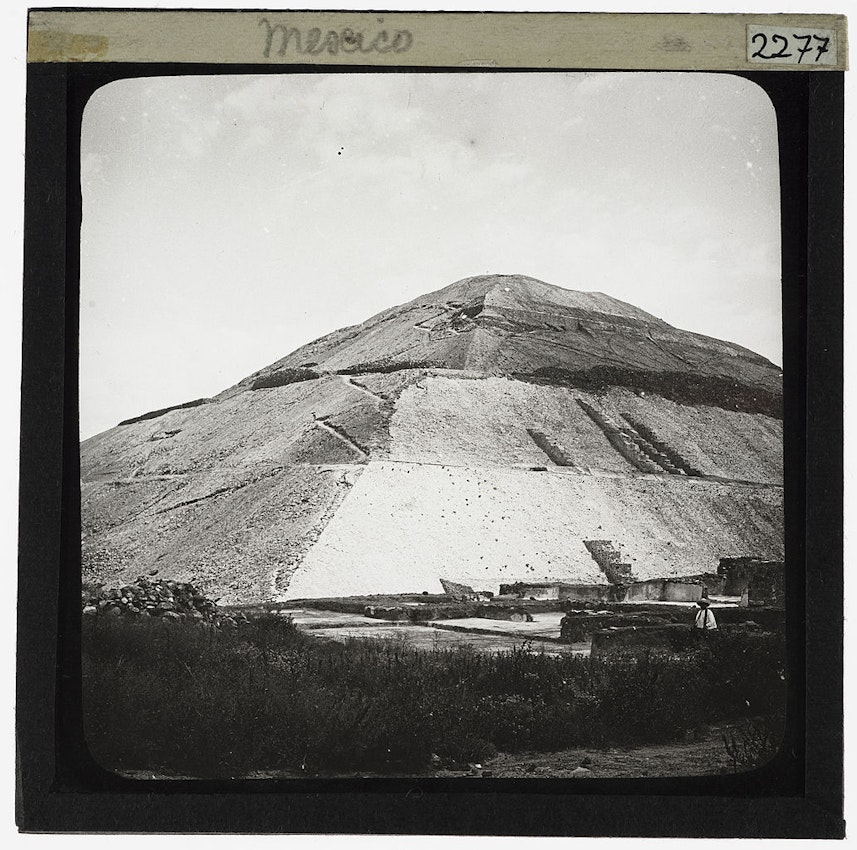 Scroll through the whole page to download all images before printing.
Scroll through the whole page to download all images before printing.Pyramid of the Sun at Teotihuacan, Mexico – YORYM : TA2277 (1906) - Source.
The next trip that really made a large impact was a return to the Caribbean in the winter of 1906-1907 to study the aftermath of the 1902 eruptions. Anderson combined this with visits to Mexico and Guatemala and the 1906 International Geological Congress in Mexico City. Anderson’s interest in the return of vegetation showed his holistic approach to the eruptions - he wasn’t just interested in the violent geomorphological phenomena but the way the volcanoes provided nutrients and changed the local ecosystems. His background in medicine also shows in his approach - he regarded close observation in the style of a ‘clinical or bedside study’
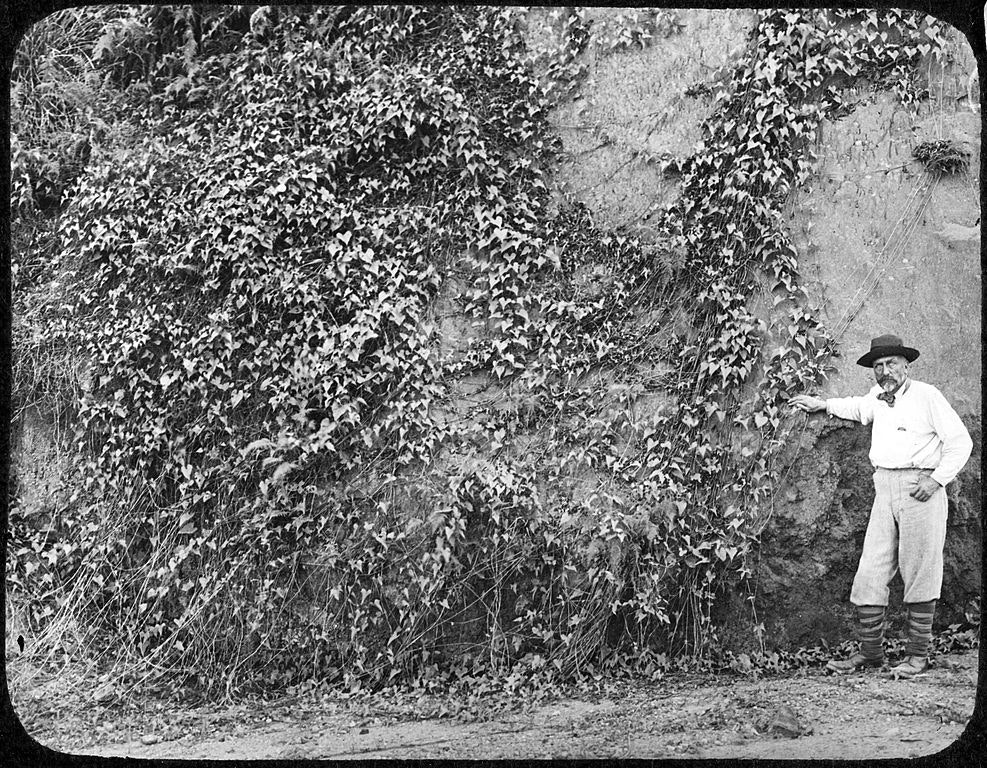 Scroll through the whole page to download all images before printing.
Scroll through the whole page to download all images before printing.Tempest Anderson and new vine growth in the Trespe Ravine, St Vincent – YORYM : TA0230 (1907) - Source.
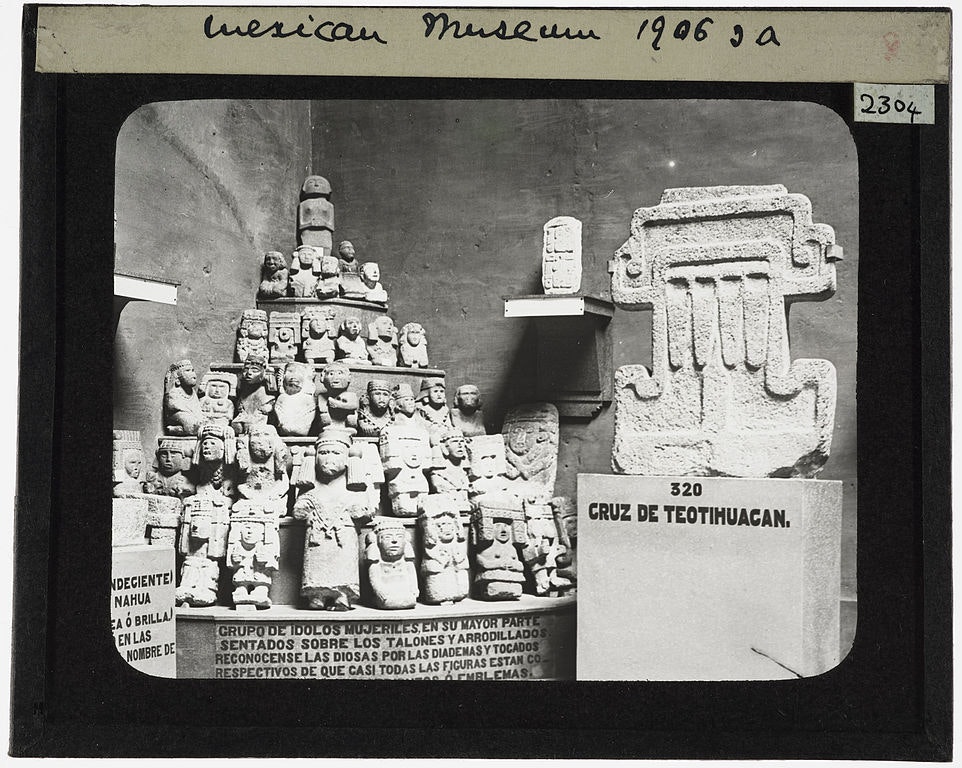 Scroll through the whole page to download all images before printing.
Scroll through the whole page to download all images before printing.A display at the Mexican Museum [of Anthropology?] YORYM : TA2304 (1906) - Source.
 Scroll through the whole page to download all images before printing.
Scroll through the whole page to download all images before printing.The crater of Santa Maria, Guatemala - YORYM : TA_2337 (1907) - Source.
The volcano of Santa Maria in Guatemala had also erupted very violently in 1902 killing around 5000 people. Anderson made studies comparing the aftermath to that of the Caribbean volcanoes.
Following this Anderson made an enormous voyage across the Pacific in 1909. Though the details of the itinerary are not clear, he visited New Zealand, Samoa, Hawaii, and then crossed the Rockies from Vancouver to the British Association meeting in Winnipeg, Canada.
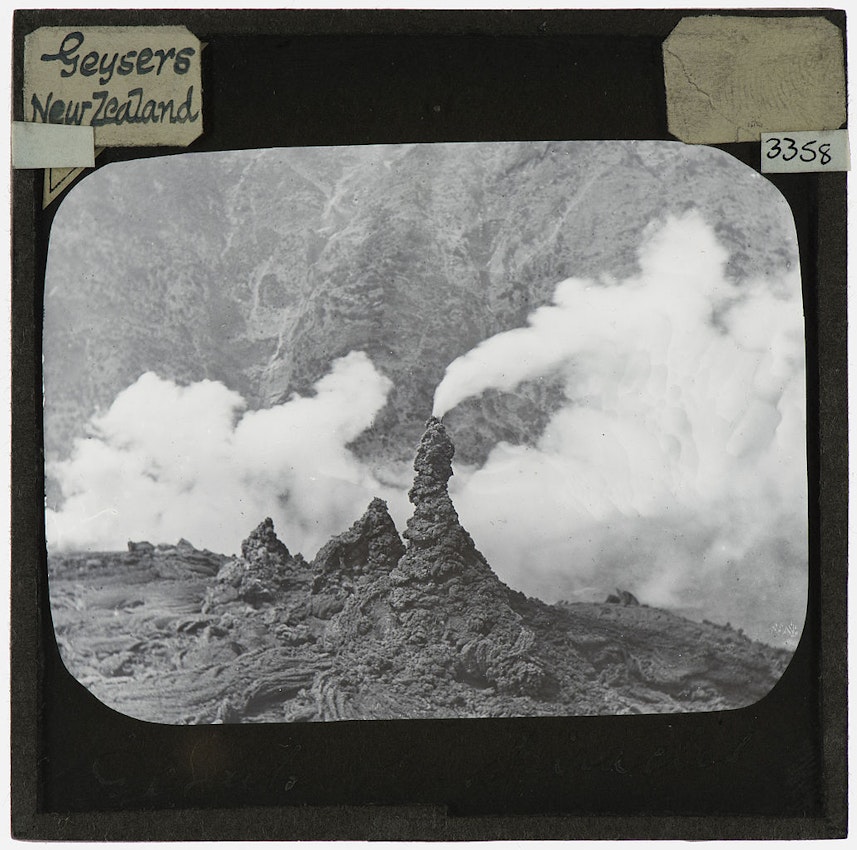 Scroll through the whole page to download all images before printing.
Scroll through the whole page to download all images before printing.1033
 Scroll through the whole page to download all images before printing.
Scroll through the whole page to download all images before printing.The caldera of Kilauea, Hawaii – YORYM : TA3234 (1909) - Source.
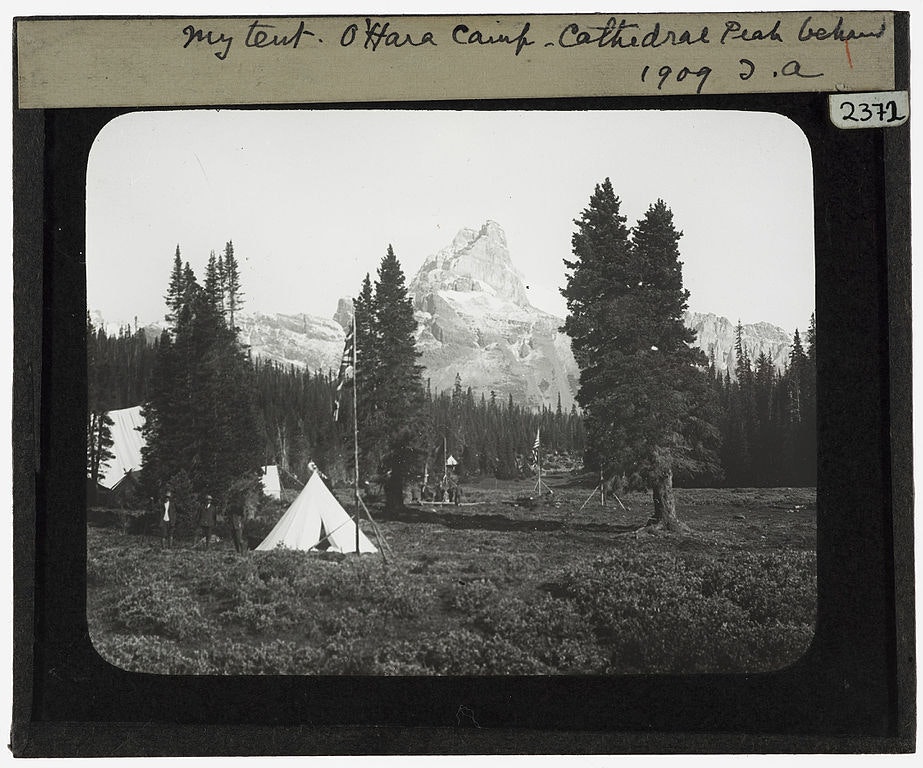 Scroll through the whole page to download all images before printing.
Scroll through the whole page to download all images before printing.‘My tent’ Tempest Anderson’s tent at O’Hara Camp with Cathedral Peak behind – YORYM: TA2372 (1909) - Source.
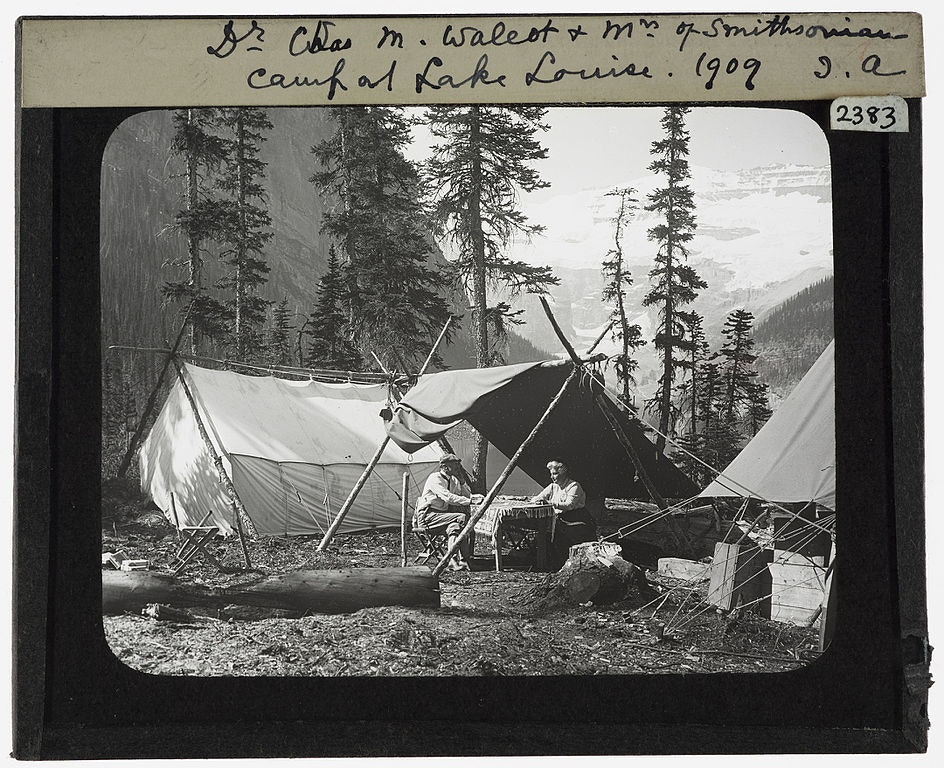 Scroll through the whole page to download all images before printing.
Scroll through the whole page to download all images before printing.Dr Charles Doolittle Walcot (of Smithsonian) and Mrs Walcot at a camp in Lake Louise - YORYM : TA2383 (1909) - Source.
The trip into the Rockies was with Charles Doolittle Walcot - the discoverer of the Burgess Shale - and a number of other geologists from around the world.
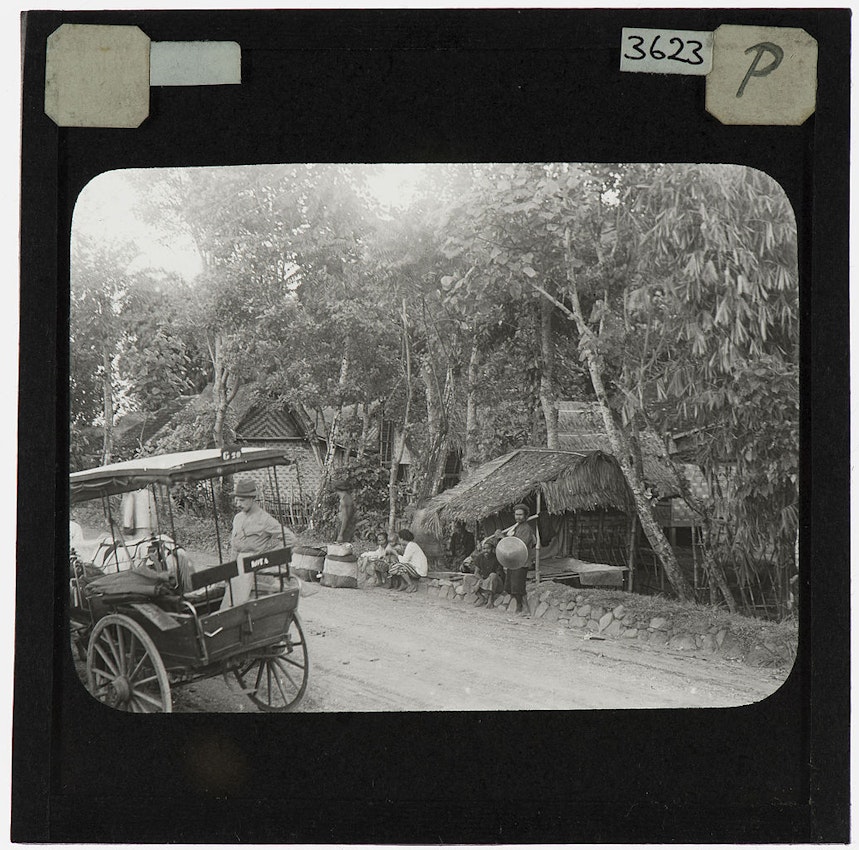 Scroll through the whole page to download all images before printing.
Scroll through the whole page to download all images before printing.Roadside view Papandayang, Java YORYM : TA3623 (1913) - Source.
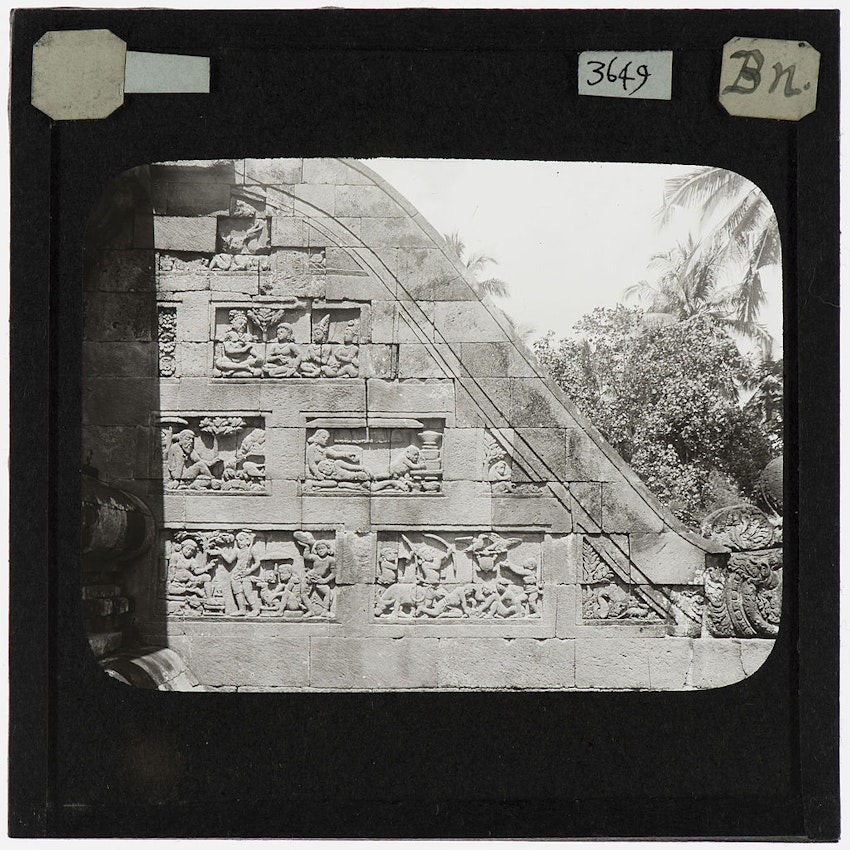 Scroll through the whole page to download all images before printing.
Scroll through the whole page to download all images before printing.Borobudur, Java – YORYM : TA3649 (1913) - Source.
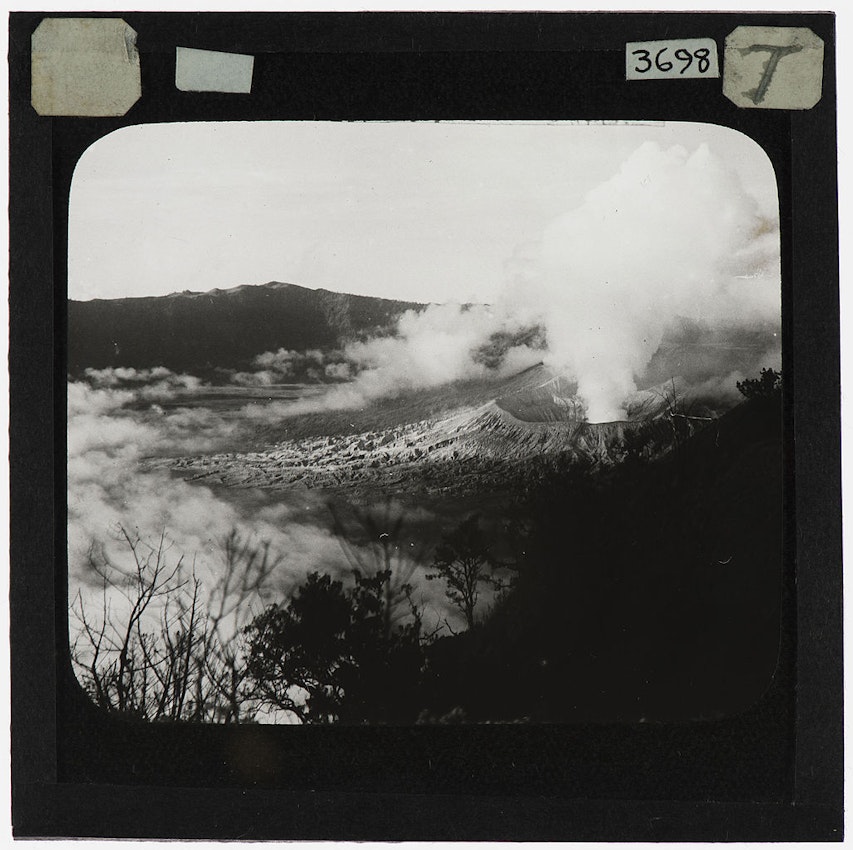 Scroll through the whole page to download all images before printing.
Scroll through the whole page to download all images before printing.Mount Bromo, Java - YORYM : TA3698 (1913) - Source.
Anderson’s final voyage was to Indonesia and the Philippines in 1913. On the return from this trip he contracted an illness on the ship and unfortunately died. He was buried at Suez, in Egypt. His loss was felt by many but a colleague had warned him several years before: “You know, Anderson, you are sure to be killed, but it will be such a very great satisfaction to you afterwards to think that it was in the cause of science.”
The legacy left by Anderson in York is understated today. The Tempest Anderson Hall was funded by Anderson in 1912, and is used by many on visits to the Yorkshire Museum, and the eagle-eyed may have spotted his plaque outside his former medical practice on Stonegate. However, few know much of the fantastic voyages made at the turn of the century by this adventurous doctor. Sharing his photographs online is a first step in telling his story.
Pat Hadley is Yorkshire’s Wikimedia Ambassador and works helping museums open up their collections online.
Sarah King is the curator of geology at the Yorkshire Museum.
Stuart Ogilvy is the curator of natural history at the Yorkshire Museum.








